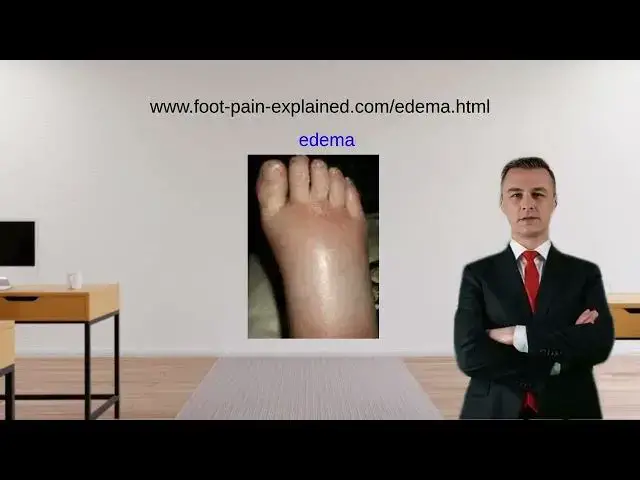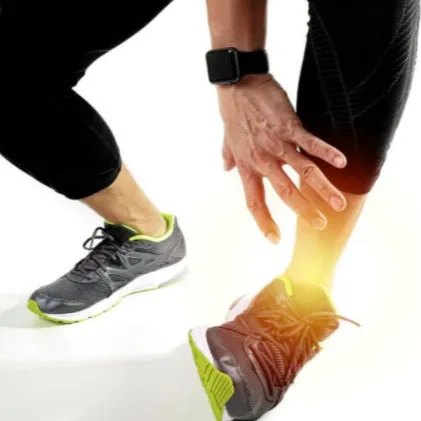What is edema and how do you treat it
https://www.foot-pain-explained.com/edema.html
@marcbarry1000
Show More Show Less View Video Transcript
0:00
edema is a condition characterized by
0:02
the buildup of excess fluid in body
0:03
tissues resulting in swelling and
0:05
discomfort it can affect various parts
0:08
of the body leading to a range of
0:09
symptoms and complications if left
0:11
untreated in this discussion we will
0:14
delve into the causes symptoms treatment
0:16
options and potential complications of
0:18
Edema taking a closer look at different
0:20
types of Edema and their impact on
0:22
primarily the lower extremity the Dema
0:24
occurs when an excessive amount of fluid
0:26
accumulates in the interstitial spaces
0:28
which are the spaces between cells in
0:30
body tissues this fluid buildup may be
0:33
caused by several factors including one
0:35
increased capillary pressure conditions
0:38
like heart failure kidney disease and
0:40
pregnancy may lead to fluid retention
0:42
due to increased pressure on the blood
0:43
vessels disrupting the balance between
0:45
fluid intake and removal from tissues 2.
0:48
reduced osmotic pressure which is a
0:50
decrease in proteins like albumin in the
0:52
blood often due to liver or kidney
0:54
disease lowers osmotic pressure causing
0:57
fluid to remain in tissues 3. lymphatic
1:00
dysfunction when the lymphatic system
1:02
fails to effectively drain excess fluid
1:04
as seen in diseases such as lymphedema
1:06
fluid collects and causes swelling 4.
1:09
inflammation inflammatory responses
1:12
triggered by trauma infection are
1:14
chronic conditions like rheumatoid
1:15
arthritis can lead to localized edema
1:18
the most common form of Edema known as
1:20
peripheral edema affects the legs ankles
1:23
and feet it can occur in one foot or
1:25
both feet causes of swelling occurring
1:28
in both feet or venous insufficiency
1:29
probably the most common cause where the
1:32
valves that pump blood back up to the
1:33
heart become incompetent over time so
1:35
the blood attempts to travel back up to
1:37
the heart but falls back down and
1:39
settles in the foot and ankles by the
1:41
end of the day the feet and ankles will
1:43
be swollen but upon arising in the
1:45
morning there is usually minimal to no
1:47
edema another factor is excessive
1:49
humidity this too will be worse at the
1:51
end of the day and much improved first
1:53
thing in the morning
1:54
standing too long without much movement
1:56
or sitting too long where there is too
1:58
much pressure on the veins in the back
2:00
of the thigh will also cause peripheral
2:01
edema this is more common in the elderly
2:04
other causes of peripheral edema include
2:06
congestive heart failure lung disease
2:08
kidney disease thyroid disease pregnancy
2:10
people with salt sensitivity medications
2:12
including vasodilators which act to open
2:14
up arteries which bring more blood down
2:16
to the extremities calcium channel
2:18
blockers which are used for high blood
2:20
pressure estrogens and NSAIDs such as
2:22
Aleve Motrin or Advil along with the
2:25
prescription versions all may cause
2:26
excess water retention this is
2:29
particularly true in older individuals
2:30
and that is why they should be avoided
2:32
in prolonged doses in those populations
2:34
causes of swelling in only one foot and
2:37
leg trauma to the foot or ankle
2:39
arthritic flare-up of a joint which will
2:41
usually mean a localized swelling in the
2:43
foot or ankle deep Venous Thrombosis DVT
2:45
which most likely is occurring in the
2:47
calf this is potentially the most
2:50
dangerous cause of unilateral swelling
2:52
and needs immediate medical attention
2:54
gout which is classified as an arthritic
2:56
flare-up will cause localized swelling
2:58
infection in the foot may also cause
3:01
localized swelling Foot and Ankle
3:03
surgery will also cause swelling after
3:05
surgery it is normal for the foot to
3:07
swell as the body is increasing the
3:08
blood flow to the surgical site in an
3:10
effort to facilitate healing lymphedema
3:13
which is an abnormal removal of
3:14
interstitial fluid fluid between cells
3:17
through a problem with the lymphatic
3:18
system this is usually due to an
3:20
obstruction of a lymph node can also
3:22
occur in both feet treatment options and
3:25
advancements 1. Lifestyle Changes
3:27
managing edema often includes
3:29
maintaining a low sodium diet staying
3:32
physically active and elevating the
3:33
affected limbs regularly to promote
3:35
fluid drainage
3:37
2. diuretics medications like diuretics
3:40
may be prescribed to promote increased
3:42
urine production reducing fluid buildup
3:44
in tissues 3. compression therapy
3:47
wearing compression garments or bandages
3:49
can help prevent or manage edema by
3:51
applying pressure to the affected area
3:53
promoting fluid drainage
3:55
4. lymphatic drainage techniques such as
3:58
manual lymphatic drainage or specialized
4:00
massages may be recommended to stimulate
4:02
the lymph flow and reduce lymphedema
4:04
potential complications and the
4:06
importance of seeking treatment if left
4:08
untreated edema can lead to a company in
4:10
complications such as pain limited
4:12
Mobility increased risk of infections
4:14
and skin ulcers it is vital to consult a
4:17
health care professional to identify the
4:19
underlying cause and begin appropriate
4:21
treatment promptly conclusion edema can
4:24
affect different parts of the body
4:25
causing discomfort and potential
4:27
complications knowing the causes
4:30
symptoms and treatment options can
4:32
Empower individuals dealing with edema
4:33
to proactively manage their condition
4:36
by seeking medical advice adopting
4:38
healthy lifestyle changes and utilizing
4:40
Innovative treatment methods individuals
4:42
can find relief and regain control over
4:44
their lives
#Other


